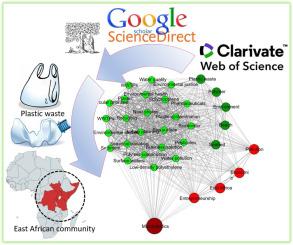东非共同体的塑料废物:现状、排放、污染和减少战略
IF 7.7
Q2 ENGINEERING, ENVIRONMENTAL
引用次数: 0
摘要
东非共同体(EAC)是一个区域性政府间组织,由七个伙伴国组成:布隆迪、刚果民主共和国、肯尼亚、卢旺达、南苏丹、坦桑尼亚和乌干达。EAC城市化快速,人口增长,塑料消费不断增加。尽管一些成员国做出了政策努力并禁止使用一次性塑料,但废物管理不足和回收措施有限阻碍了有效减少塑料废物。尽管塑料废物和微塑料构成重大风险,但目前没有全面审查详细说明其在东亚共同体内的流行情况、缓解战略和健康影响。本文综述了东亚共同体国家塑料垃圾的现状和差距、塑料垃圾向海洋的排放以及东亚共同体水体中微塑料的污染。它强调了解决塑料废物的现有缓解战略。此外,还提出了控制和减轻塑料废物的建议,概述了概念方面和实际方法。加强区域合作、改善废物管理系统和促进可持续替代品对解决塑料废物问题至关重要。通过教育宣传和运动,再加上开发无毒塑料替代品和实施有效的处置或回收战略,可以为在日常生活中使用塑料材料带来许多好处,因为它们价格合理,用途广泛。由于现有的研究仍然有限,需要进一步的调查来检测EAC水体中的微塑料和纳米塑料。本文章由计算机程序翻译,如有差异,请以英文原文为准。

Plastic waste in the East African Community (EAC): status, discharge, contamination, and mitigation strategies
The East African Community (EAC) is a regional intergovernmental organization comprising seven partner states: Burundi, the Democratic Republic of Congo, Kenya, Rwanda, South Sudan, Tanzania, and Uganda. EAC has a rapid urbanization, population growth, and increasing plastic consumption. Despite policy efforts and bans on single-use plastics in some member states, inadequate waste management and limited recycling initiatives hinder effective plastic waste reduction. Although plastic waste and microplastics pose significant pose significant concerning risks, there is currently no comprehensive review detailing their prevalence, mitigation strategies, and health impact within EAC. This review explores the status and gaps regarding plastic waste in EAC countries, its discharge to the ocean, and microplastic contamination in EAC water bodies. It highlights the existing mitigation strategies to address plastic waste. Furthermore, suggestions for controlling and mitigating plastic waste are delineated, outlining both conceptual aspects and practical approaches. Strengthening regional cooperation, improving waste management systems, and promoting sustainable alternatives are crucial for tackling plastic waste. Through educational outreach and campaigns, coupled with the development of non-toxic plastic alternatives and the implementation of effective disposal or recycling strategies, can yield numerous advantages for the use of plastic materials in everyday human life, given their affordability and versatility. Further investigations are needed to detect microplastics and nanoplastics in water bodies across the EAC, as existing research remains limited.
求助全文
通过发布文献求助,成功后即可免费获取论文全文。
去求助
来源期刊

Journal of hazardous materials advances
Environmental Engineering
CiteScore
4.80
自引率
0.00%
发文量
0
审稿时长
50 days
 求助内容:
求助内容: 应助结果提醒方式:
应助结果提醒方式:


